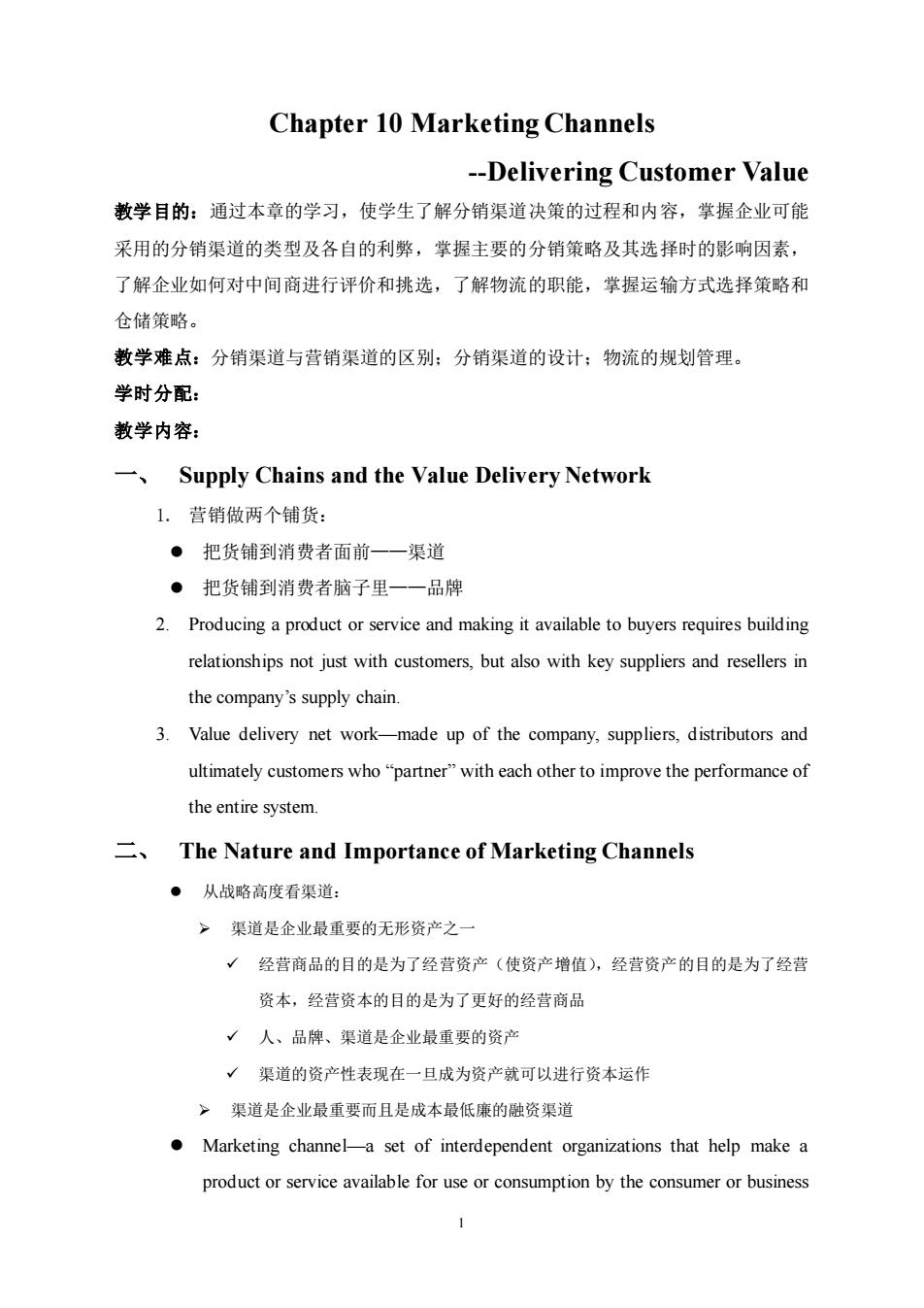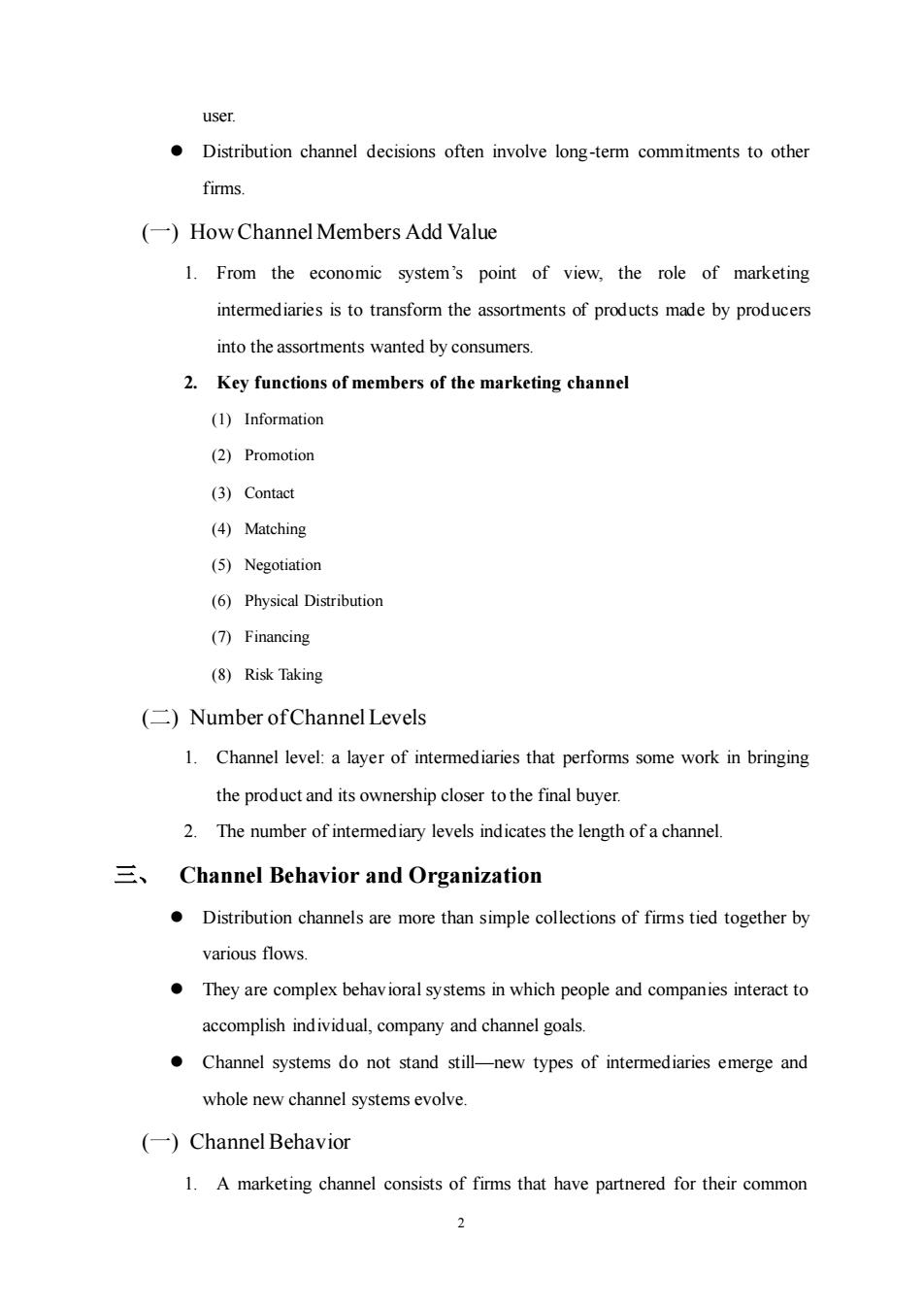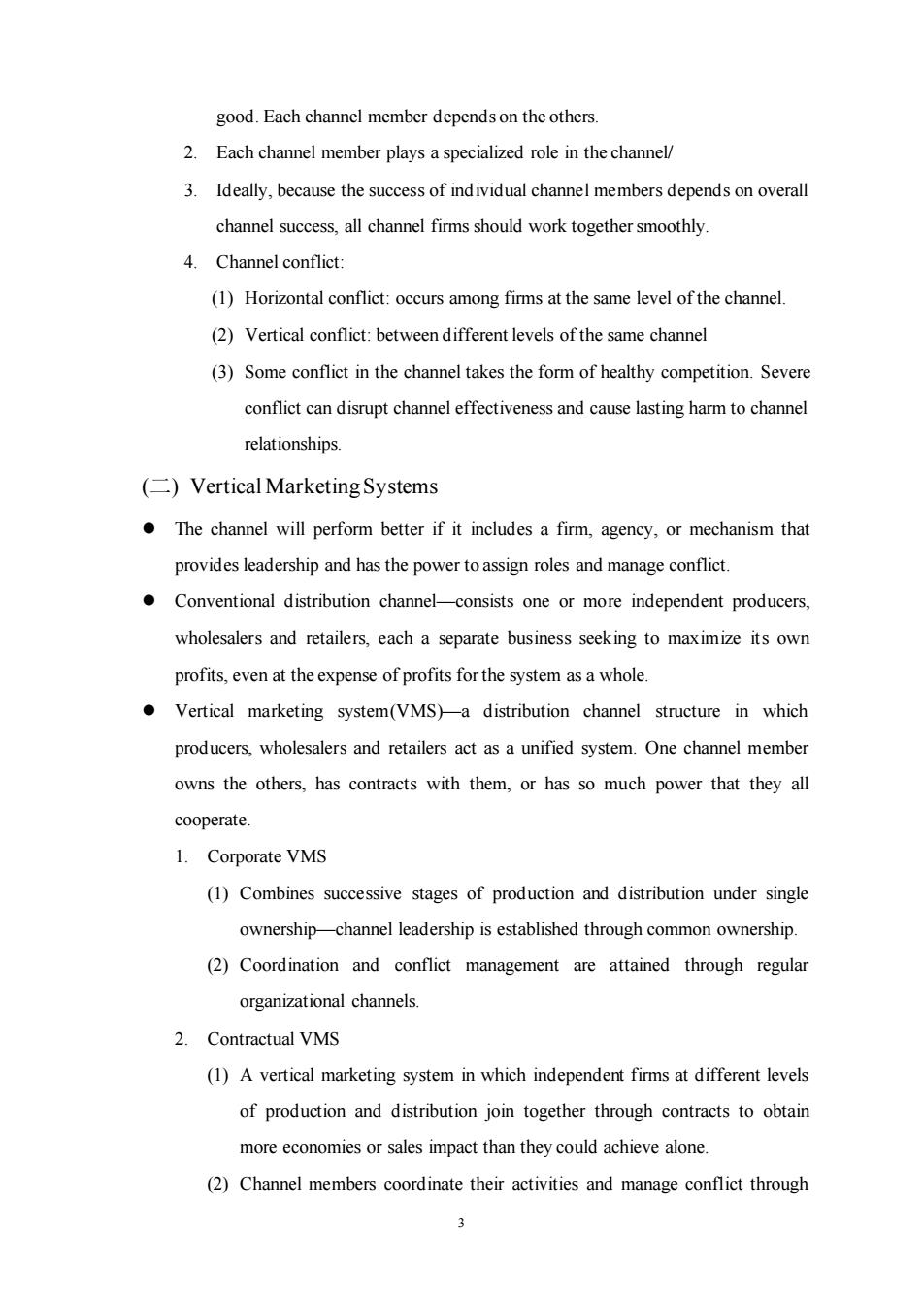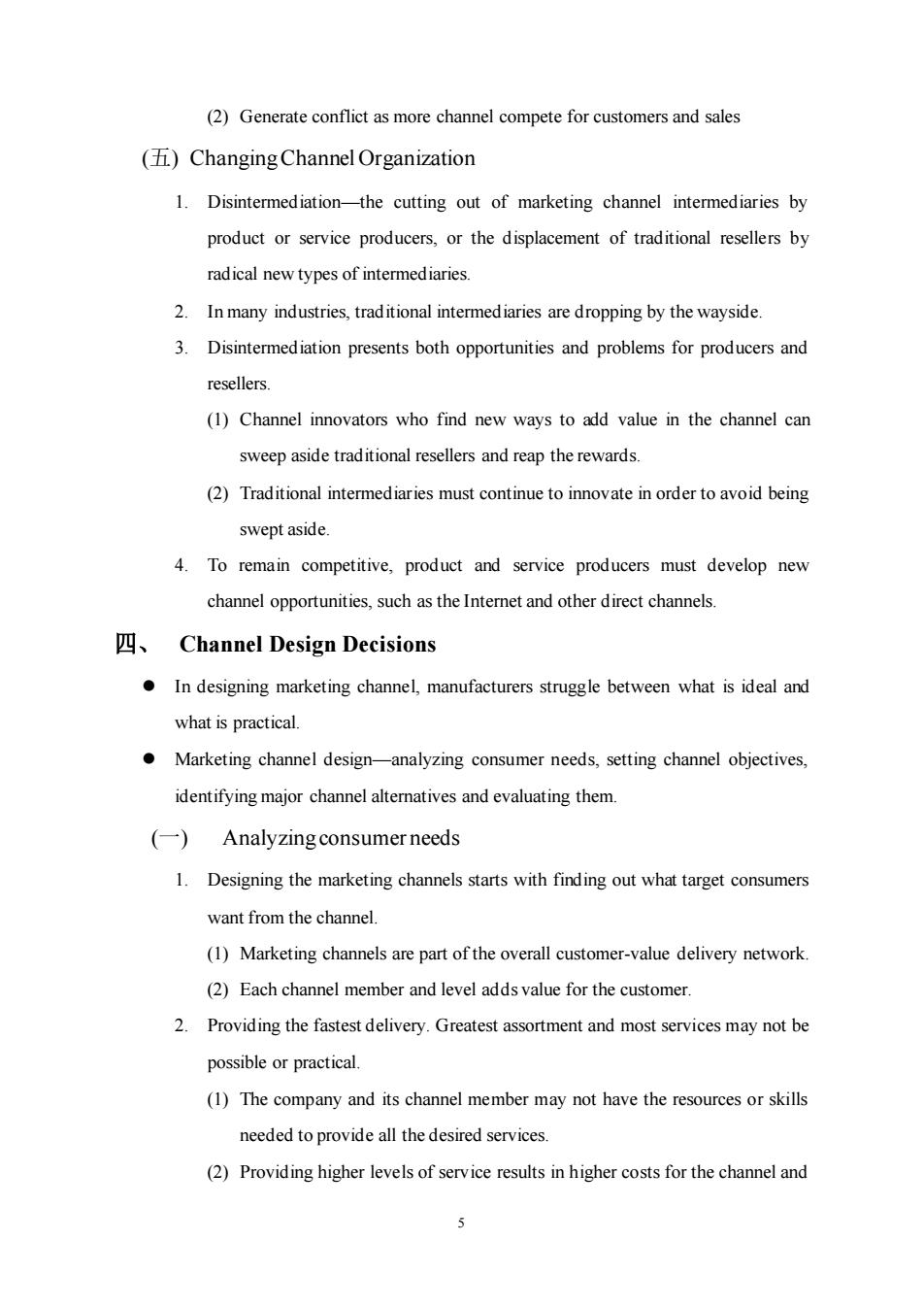
Chapter 10 Marketing Channels -Delivering Customer Value 教学目的:通过本章的学习,使学生了解分销渠道决策的过程和内容,掌握企业可能 采用的分销渠道的类型及各自的利弊,掌握主要的分销策略及其选择时的影响因素, 了解企业如何对中间商进行评价和挑选,了解物流的职能,掌握运输方式选择策略和 仓储策略。 教学难点:分销渠道与营销渠道的区别:分销渠道的设计:物流的规划管理。 学时分配: 教学内容: Supply Chains and the Value Delivery Network 1.营销做两个铺货: ·把货铺到消费者面前一一渠道 ●把货铺到消费者脑子里一一品牌 2.Producing a product or service and making it available to buyers requires building relationships not just with customers,but also with key suppliers and resellers in the company's supply chain. 3.Value delivery net work-made up of the company,suppliers,distributors and ultimately customers who"partner"with each other to improve the performance of the entire system. The Nature and Importance of Marketing Channels 。从战略高度看渠道: >集道是企业最重要的无形资产之 √经营商品的目的是为了经营资产(使资产增值),经营资产的目的是为了经营 资本,经营资本的目的是为了更好的经营商品 √人、品牌、渠道是企业最重要的资产 √渠道的资产性表现在一且成为资产就可以进行资本运作 >渠道是企业最重要而且是成本最低廉的融资渠道 Marketing channela set of interdependent organizations that help make a product or service available for use or consumption by the consumer or business
1 Chapter 10 Marketing Channels -Delivering Customer Value 教学目的:通过本章的学习,使学生了解分销渠道决策的过程和内容,掌握企业可能 采用的分销渠道的类型及各自的利弊,掌握主要的分销策略及其选择时的影响因素, 了解企业如何对中间商进行评价和挑选,了解物流的职能,掌握运输方式选择策略和 仓储策略。 教学难点:分销渠道与营销渠道的区别;分销渠道的设计;物流的规划管理。 学时分配: 教学内容: 一、 Supply Chains and the Value Delivery Network 1. 营销做两个铺货: ⚫ 把货铺到消费者面前——渠道 ⚫ 把货铺到消费者脑子里——品牌 2. Producing a product or service and making it available to buyers requires building relationships not just with customers, but also with key suppliers and resellers in the company’s supply chain. 3. Value delivery net work—made up of the company, suppliers, distributors and ultimately customers who “partner” with each other to improve the performance of the entire system. 二、 The Nature and Importance of Marketing Channels ⚫ 从战略高度看渠道: ➢ 渠道是企业最重要的无形资产之一 ✓ 经营商品的目的是为了经营资产(使资产增值),经营资产的目的是为了经营 资本,经营资本的目的是为了更好的经营商品 ✓ 人、品牌、渠道是企业最重要的资产 ✓ 渠道的资产性表现在一旦成为资产就可以进行资本运作 ➢ 渠道是企业最重要而且是成本最低廉的融资渠道 ⚫ Marketing channel—a set of interdependent organizations that help make a product or service available for use or consumption by the consumer or business

user. Distribution channel decisions often involve long-term commitments to other firms. (-)How Channel Members Add Value 1.From the economic system's point of view,the role of marketing intermediaries is to transform the assortments of products made by producers into the assortments wanted by consumers. 2.Key functions of members of the marketing channel (l))Information (2)Promotion (3)Contact (4)Matching (5)Negotiation (6)Physical Distribution (7)Financing (8)Risk Taking ()Number ofChannel Levels 1.Channel level:a layer of intermediaries that performs some work in bringing the product and its ownership closer to the final buyer 2.The number of intermediary levels indicates the length of a channel. 三、Channel Behavior and Organization Distribution channels are more than simple collections of firms tied together by various flows. They are complex behavioral systems in which people and companies interact to accomplish individual,company and channel goals. Channel systems do not stand still-new types of intermediaries emerge and whole new channel systems evolve. (-)Channel Behavior 1.A marketing channel consists of firms that have partnered for their common 2
2 user. ⚫ Distribution channel decisions often involve long-term commitments to other firms. (一) How Channel Members Add Value 1. From the economic system’s point of view, the role of marketing intermediaries is to transform the assortments of products made by producers into the assortments wanted by consumers. 2. Key functions of members of the marketing channel (1) Information (2) Promotion (3) Contact (4) Matching (5) Negotiation (6) Physical Distribution (7) Financing (8) Risk Taking (二) Number of Channel Levels 1. Channel level: a layer of intermediaries that performs some work in bringing the product and its ownership closer to the final buyer. 2. The number of intermediary levels indicates the length of a channel. 三、 Channel Behavior and Organization ⚫ Distribution channels are more than simple collections of firms tied together by various flows. ⚫ They are complex behavioral systems in which people and companies interact to accomplish individual, company and channel goals. ⚫ Channel systems do not stand still—new types of intermediaries emerge and whole new channel systems evolve. (一) Channel Behavior 1. A marketing channel consists of firms that have partnered for their common

good.Each channel member dependson the others 2.Each channel member plays a specialized role in the channel 3.Ideally,because the success of individual channel members depends on overall channel success,all channel firms should work together smoothly 4.Channel conflict (1)Horizontal conflict:occurs among fimms at the same level ofthe channel. (2)Vertical conflict:between different levels ofthe same channel (3)Some conflict in the channel takes the form of healthy competition.Severe conflict can disrupt channel effectiveness and cause lasting harm to channel relationships. ()Vertical Marketing Systems The channel will perform better if it includes a firm,agency,or mechanism that provides leadership and has the power to assign roles and manage conflict. Conventional distribution channel-consists one or more independent producers. wholesalers and retailers,each a separate business seeking to maximize its own profits,even at the expense of profits for the system as a whole. Vertical marketing system(VMS)a distribution channel structure in which producers,wholesalers and retailers act as a unified system.One channel member owns the others,has contracts with them,or has so much power that they all cooperate. 1.Corporate VMS (1)Combines successive stages of production and distribution under single ownership-channel leadership is established through common ownership. (2)Coordination and conflict management are attained through regular organizational channels. 2.Contractual VMS (1)A vertical marketing system in which independent firms at different levels of production and distribution join together through contracts to obtain more economies or sales impact than they could achieve alone (2)Channel members coordinate their activities and manage conflict through
3 good. Each channel member depends on the others. 2. Each channel member plays a specialized role in the channel/ 3. Ideally, because the success of individual channel members depends on overall channel success, all channel firms should work together smoothly. 4. Channel conflict: (1) Horizontal conflict: occurs among firms at the same level of the channel. (2) Vertical conflict: between different levels of the same channel (3) Some conflict in the channel takes the form of healthy competition. Severe conflict can disrupt channel effectiveness and cause lasting harm to channel relationships. (二) Vertical Marketing Systems ⚫ The channel will perform better if it includes a firm, agency, or mechanism that provides leadership and has the power to assign roles and manage conflict. ⚫ Conventional distribution channel—consists one or more independent producers, wholesalers and retailers, each a separate business seeking to maximize its own profits, even at the expense of profits for the system as a whole. ⚫ Vertical marketing system(VMS)—a distribution channel structure in which producers, wholesalers and retailers act as a unified system. One channel member owns the others, has contracts with them, or has so much power that they all cooperate. 1. Corporate VMS (1) Combines successive stages of production and distribution under single ownership—channel leadership is established through common ownership. (2) Coordination and conflict management are attained through regular organizational channels. 2. Contractual VMS (1) A vertical marketing system in which independent firms at different levels of production and distribution join together through contracts to obtain more economies or sales impact than they could achieve alone. (2) Channel members coordinate their activities and manage conflict through

contractual agreements (3)The franchise organization is the most common type of contractual relationship-a channel member,called a franchisor,links several stages in the production-distribution process 1)Manufacturer-sponsored retailer franchise system 2)Manufacturer-sponsored wholesaler franchise system 3)Service-firm-sponsored retailer franchise system 3.Administered VMS (1)Coordinates successive stages of production and distribution,not through common ownership or contractual ties,but through the size and power of one of the parties. (2)Manufacturers of a top brand can obtain strong trade cooperation and support from resellers. (Horizontal Marketing Systems 1.Two or more companies at one level join together to follow a new marketing opportunity. 2.By working together,companies can combine their financial,production or marketing resources to accomplish more than any one company could alone 3.Companies might join forces with competitors or noncompetitors 4.Such channel arrangements also work well globally. (Multichannel Distribution Systems 1.A single firm sets up two or more marketing channels to reach one or more customer segments 2.Every large company and many small ones distribute through multiple channels 3.Offer many advantages to companies facing large and complex markets. (1)Expand sales and market coverage (2)Gain opportunities to tailor its products and services to the specific needs of diverse customer segments 4.Disadvantages: (1)Harderto control 4
4 contractual agreements. (3) The franchise organization is the most common type of contractual relationship—a channel member, called a franchisor, links several stages in the production-distribution process. 1) Manufacturer-sponsored retailer franchise system 2) Manufacturer-sponsored wholesaler franchise system 3) Service-firm-sponsored retailer franchise system 3. Administered VMS (1) Coordinates successive stages of production and distribution, not through common ownership or contractual ties, but through the size and power of one of the parties. (2) Manufacturers of a top brand can obtain strong trade cooperation and support from resellers. (三) Horizontal Marketing Systems 1. Two or more companies at one level join together to follow a new marketing opportunity. 2. By working together, companies can combine their financial, production or marketing resources to accomplish more than any one company could alone. 3. Companies might join forces with competitors or noncompetitors. 4. Such channel arrangements also work well globally. (四) Multichannel Distribution Systems 1. A single firm sets up two or more marketing channels to reach one or more customer segments. 2. Every large company and many small ones distribute through multiple channels. 3. Offer many advantages to companies facing large and complex markets. (1) Expand sales and market coverage (2) Gain opportunities to tailor its products and services to the specific needs of diverse customer segments 4. Disadvantages: (1) Harder to control

(2)Generate conflict as more channel compete for customers and sales (Changing Channel Organization 1.Disintermediation-the cutting out of marketing channel intermediaries by product or service producers,or the displacement of traditional resellers by radical new types of intermediaries 2.In many industries,traditional intermediaries are dropping by the wayside. 3.Disintermediation presents both opportunities and problems for producers and (1)Channel innovators who find new ways to add value in the channel can sweep aside traditional resellers and reap the rewards. (2)Traditional intermediaries must continue to innovate in order to avoid being swept aside. 4.To remain competitive,product and service producers must develop new channel opportunities,such as the Intemet and other direct channels. 四、Channel Design Decisions In designing marketing channel,manufacturers struggle between what is ideal and what is practical. Marketing channel design-analyzing consumer needs,setting channel objectives. identifying major channel alternatives and evaluating them. (-)Analyzingconsumer needs 1.Designing the marketing channels starts with finding out what target consumers want from the channel. (1)Marketing channels are part of the overall customer-value delivery network (2)Each channel member and level adds value for the customer. 2.Providing the fastest delivery.Greatest assortment and most services may not be possible or practical. (1)The company and its channel member may not have the resources or skills needed to provide all the desired services (2)Providing higher levels of service results in higher costs for the channel and
5 (2) Generate conflict as more channel compete for customers and sales (五) Changing Channel Organization 1. Disintermediation—the cutting out of marketing channel intermediaries by product or service producers, or the displacement of traditional resellers by radical new types of intermediaries. 2. In many industries, traditional intermediaries are dropping by the wayside. 3. Disintermediation presents both opportunities and problems for producers and resellers. (1) Channel innovators who find new ways to add value in the channel can sweep aside traditional resellers and reap the rewards. (2) Traditional intermediaries must continue to innovate in order to avoid being swept aside. 4. To remain competitive, product and service producers must develop new channel opportunities, such as the Internet and other direct channels. 四、 Channel Design Decisions ⚫ In designing marketing channel, manufacturers struggle between what is ideal and what is practical. ⚫ Marketing channel design—analyzing consumer needs, setting channel objectives, identifying major channel alternatives and evaluating them. (一) Analyzing consumer needs 1. Designing the marketing channels starts with finding out what target consumers want from the channel. (1) Marketing channels are part of the overall customer-value delivery network. (2) Each channel member and level adds value for the customer. 2. Providing the fastest delivery. Greatest assortment and most services may not be possible or practical. (1) The company and its channel member may not have the resources or skills needed to provide all the desired services. (2) Providing higher levels of service results in higher costs for the channel and